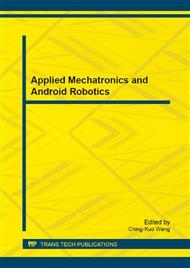[1]
N. Shirokoshi: Studies of Influences of Geometrical Errors to Final Performances in Small Backlash Planetary Gears, JSME vol66-646(2000-6).
Google Scholar
[2]
K.S. Jeong, D.G. Lee, S.H. Oh: Development of composite flexspline for a cycloid-type harmonic drive using net shape manufacturing method, Composite Structures, 32 (1995) pp.557-565.
DOI: 10.1016/0263-8223(95)80024-7
Google Scholar
[3]
H. S . Oh, K. S. Jeong and D. G. Lee, Design and manufacture of the composite flexspline of a harmonic drive with adhesive joining, Composite Structures, Vol. 28, (1994), pp.307-314.
DOI: 10.1016/0263-8223(94)90017-5
Google Scholar
[4]
R. Haraguchi: Development of output coupling mechanisms using the harmonic drive, Proc. vol. 2, 2004IEEE/RSJ (2004)pp.1275-1280.
Google Scholar
[5]
Y. Kiyosawa: Introduction of Ultra Flat Strain Wave Gearing, JSME, No04-17, pp.76-79 (2004).
Google Scholar
[6]
M. Hashimoto, I. Godler: Built-in High Accuracy Torque Sending For Harmonic Drive Gears, JRSJ, vol15-5, pp.802-806(1997).
DOI: 10.7210/jrsj.15.802
Google Scholar
[7]
S. Yanabe: Torsional stiffness of Harmonic Drive Reducers, JSME, vol55-509, pp.216-221 (1989).
Google Scholar
[8]
T. Oguri: Backlash compensation of reduction gears by twin moter cooperative control 602 JSME 145-146(2006).
Google Scholar
[9]
K. Gotouda: Experimental Analysis about the Influence of Alignment Error on Transmission Error of Planetary Gears; JSME vol4, 37-38(2008).
Google Scholar
[10]
N. Ito,H. Hasegawa: Robust Optimization of the Gait for a Biped Robot on External Factors, JSME, No08-35 (2008) , 47-52.
Google Scholar
[11]
C. Sabourin,O. Bruneau: Robustness of the dynamic walk of a biped robot subjected to disturbing external forces by using CMAC neural networks, Robotics and Autonomous Systems 51(2005)81–99.
DOI: 10.1016/j.robot.2005.02.001
Google Scholar
[12]
H. Sakamoto,H. Katayose,K. Miyazaki,R. Nakatsu: Extended-knee walk for humanoid robot with parallel link legs, IJHB vol. 6 No. 4, (2009)pp.565-584.
DOI: 10.1142/s0219843609001917
Google Scholar
[13]
A. Sano and J. Furusho, Realization of natural dynamic walking using the angular momentum information, IEEE Int. Conf. on Robotics and Automation, Vol. 3, (1990), pp.1476-1481.
DOI: 10.1109/robot.1990.126214
Google Scholar
[14]
M. Harrass, K. Friedrich, A.A. Almajid: Tribological behavior of selected engineering polymers under rolling contact, Trib. int. 2009 doi: 10. 1016/j. triboint. 2009. 10. 003.
DOI: 10.1016/j.triboint.2009.10.003
Google Scholar
[15]
K. D. Dearn, S. N. Kukureka and D. Walton, Engineering polymers and composites for machine elements, In: SinhaSK, BriscoeBJ, editors, Polymer Tribology, London UK: Imperial College 154 Press, (2009), pp.470-505.
DOI: 10.1142/9781848162044_0014
Google Scholar
[16]
H. Koike, K. Kanemasu, K. Itakura, K. Saruwatari,J. Rozwadowska, M. Uryu, E.C. Santos, K. Kida: Wear and transmission error between PEEK bush and 7075 aluminium alloy cam plate components in robot joints, Applied Mechanics and Materials Vol. 307 (2013).
DOI: 10.4028/www.scientific.net/amm.307.3
Google Scholar
[17]
H. Koike, K. Kida, K. Kanemasu: Influence of wear and backlash on machined PEEK polymer bushes and 7075 Aluminium alloy cam plates used in robot joints, Applied Mechanics and Materials Vols. 157-158 (2012).
DOI: 10.4028/www.scientific.net/amm.157-158.1178
Google Scholar
[18]
K. Itakura, H. Koike, K. Kida, K. Kanemasu: Measurement of Joint Element Transmission Error in a Humanoid Walking Robot, Advanced Materials Research Vol. 566 (2012) pp.348-352, doi: 10. 4028/www. scientific. net/AMR. 566. 348.
DOI: 10.4028/www.scientific.net/amr.566.348
Google Scholar
[19]
H. Koike, K. Kida, K. Kanemasu: Influence of wear and thermal deformation on machined PEEK plastic bush and Ti crank shaft, International Congress on Advanced Materials2011, 6054P.
DOI: 10.1177/0967391112020001-223
Google Scholar
[20]
J. Hanchi, N.S. Eiss, Jr: Dry sliding friction and wear of short carbon-fiber-reinforced poly-ether-ether-ketone (PEEK) at elevated temperatures, Wear 203-204 ( 1997) 380-386.
DOI: 10.1016/s0043-1648(96)07347-4
Google Scholar
[21]
K. Friedrich, J. Karger-Kocsis, Z. Lu: Effects of steel counterface roughness and temperature on friction and wear of PE(E)K-composites under dry sliding conditions, Wear, 148 (1991), p.235–247.
DOI: 10.1016/0043-1648(91)90287-5
Google Scholar
[22]
G. Zhang, Z. Rasheva, A.K. Schlarb: Friction and wear variations of short carbon fiber (SCF) /PTFE/graphite (10 vol. %) filled PEEK: Effects of fiber orientation and nominal contact pressure, Wear 268 (2010) 893–89.
DOI: 10.1016/j.wear.2009.12.001
Google Scholar
[23]
J. Bijwe, S. Sen, A. Ghosh: Influence of PTFE content in PEEK-PTFE blends on mechanical properties and tribo-performance in various wear modes, Wear 258(2005)pp.1536-1542.
DOI: 10.1016/j.wear.2004.10.008
Google Scholar


